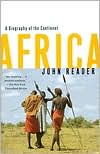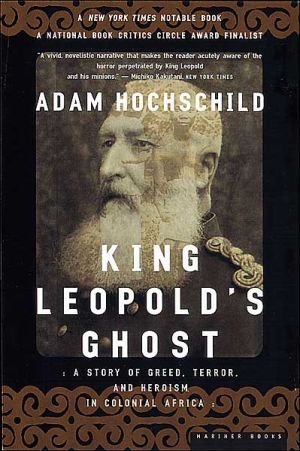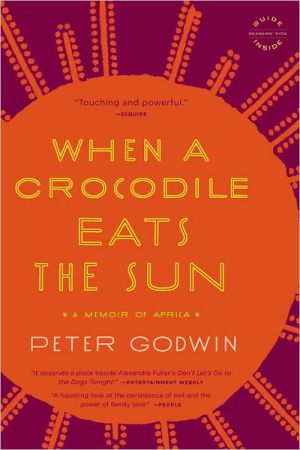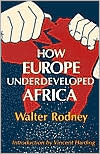Africa: A Biography of the Continent
"Awe-inspiring . . . a masterly synthesis."\ —The New York Times Book Review\ "Deeply penetrating, intensely thought-provoking and thoroughly informed . . . one of the most important general surveys of Africa that has been produced in the last decade." —The Washington Post\ In 1978, paleontologists in East Africa discovered the earliest evidence of our divergence from the apes: three pre-human footprints, striding away from a volcano, were preserved in the petrified surface of a mudpan over...
Search in google:
"Awe-inspiring . . . a masterly synthesis." —The New York Times Book Review"Deeply penetrating, intensely thought-provoking and thoroughly informed . . . one of the most important general surveys of Africa that has been produced in the last decade." —The Washington PostIn 1978, paleontologists in East Africa discovered the earliest evidence of our divergence from the apes: three pre-human footprints, striding away from a volcano, were preserved in the petrified surface of a mudpan over three million years ago. Out of Africa, the world's most ancient and stable landmass, Homo sapiens dispersed across the globe. And yet the continent that gave birth to human history has long been woefully misunderstood and mistreated by the rest of the world.In a book as splendid in its wealth of information as it is breathtaking in scope, British writer and photojournalist John Reader brings to light Africa's geology and evolution, the majestic array of its landforms and environments, the rich diversity of its peoples and their ways of life, the devastating legacies of slavery and colonialism as well as recent political troubles and triumphs. Written in simple, elegant prose and illustrated with Reader's own photographs, Africa: A Biography of the Continent is an unforgettable book that will delight the general reader and expert alike. "Breathtaking in its scope and detail." —San Francisco Chronicle Brian W. Jones Breathtaking in its scope and detail. -- San Francisco Chronicle
The ancestors of all humanity evolved in Africa. The earliest evidence of their existence has been found in East Africa, at locations scattered north and south of the Equator; the evidence consists of fossil bones, stone tools and, most poignant of all, a trail of footprints preserved in the petrified surface of a mud pan. Three individuals -- two adults and one juvenile -- walked across the pan more than 3 million years ago, moving without evident haste away from the volcano which was puffing clouds of fine ash over the landscape behind them. Their footsteps took them towards the woods and grasslands which are now known as the Serengeti plains.\ The human ancestors made their living from and among the animals with whom they shared the landscape. They were diminutive figures -- neither large nor numerous -- who existed nowhere else on Earth for over 4 million years. The modern human species, Homo sapiens, with large brain and a talent for innovation, evolved from the ancestral stock towards the end of that period.\ About 100,000 years ago, groups of modern humans left Africa for the first time and progressively colonized the rest of the world. Innovative talent carried them into every exploitable niche. They moved across the Sinai peninsula and were living in the eastern Mediterranean region by 90,000 years ago. They had reached Asia and Australia by 40,000 years ago, and Europe by 30,000 years ago. They had crossed the Bering Straits by 15,000 years ago and had reached the southernmost tip of South America by 12,000 years ago. The last remaining large habitable land mass, New Zealand, was colonized 700 years ago.\ By the early 1970s people had been to the moon. Such achievements, and all by virtue of talents which had evolved in Africa.\ Africa is only the second largest continent, but it contains 22 per cent of the Earth's land surface. The Sahara desert alone is as large as the continental United States. In fact, the United States, China, India, and New Zealand could all fit within the African coastline, together with Europe from the Atlantic to Moscow and much of South America. But Africa is much less densely populated, with less than one-quarter of the population of the other regions. Indeed, there are more people living in India (with one-tenth the land area) than in all of Africa.\ Distances within the continent are vast -- 7,000 kilometres from the Cape of Good Hope in the south to Cairo in the north, and approximately the same distance again from Dakar in the west to the tip of the Horn of Africa in the east. The Nile is the world's longest river -- 6,695 kilometres from source to estuary; both the Congo and the Niger rivers are more than 4,000 kilometres long and the Congo alone drains a basin covering 3.7 million square kilometres, which is larger than all of India (3.2 million square kilometres); on the world scale, only the Amazon basin is larger -- 7.05 million square kilometres.\ Size is one thing, but the position a continent occupies on the globe is also vitally important in terms of the ecological potential it offers a human population. Antarctica, for instance, measures 16 million square kilometres and offers nothing. Africa, on the other hand, straddles the Equator and offers a great deal. It is the oldest and most stable land mass on Earth, and the evolutionary cradle of countless plant and animal species -- including humans. And yet, although humanity evolved in Africa and is self-evidently an expression of the continent's exceptional fecundity, the species appears to have been unable to exploit its full potential within the boundaries of the continent -- in terms of either numbers or achievements.\ If modern civilization and technological culture are judged to be the epitome of human achievement, then it is unlikely that the material way of life to which most of humanity currently aspires would have developed if those small bands of modern humans had not left Africa 100,000 years ago. All the accepted markers of civilization occurred first in non-African locales -- metallurgy, agriculture, written language, the founding of cities.\ This is not to make a qualitative judgement. Who knows, but for the influence of the out-of-Africa population, a superior alternative to modern civilization and its technological culture might have evolved in Africa. Indeed, the civilized art of living peaceably in small societies without forming states that was evident in Africa prior to the arrival of external influences is a distinctively African contribution to human history. And in any event, civilization, culture and technology are very recent -- if not ephemeral -- expressions of the human condition. Biology is far more relevant. But here too there are differences that must be explained, particularly in terms of human-population growth potential.\ The imperial rulers of China conducted a census in AD 2 and found that at least 57.6 million people lived in China at the time. Written records similarly indicate that the population of the Roman Empire in AD 14 was 54 million. The population of India during the same period cannot have been less than that of the Roman Empire, and probably at least the same number of people inhabited the Americas and Australasia.\ Thus, the modern humans who emigrated from Africa around 100,000 years ago, though possibly numbering no more than one hundred when they left, had multiplied into a global population of more than 200 million people by the beginning of the modern era.\ Such an impressive growth of numbers is quite within the range of human reproductive capacity and it begs the question: if this was the extent to which the out-of-Africa human population had expanded, how fared the population which had remained within the continent?\ It has been estimated that about 1 million people inhabited Africa when the emigrants left the continent 100,000 years ago. By AD 200 numbers are said to have risen to 20 million -- of whom more than half lived in North Africa and the Nile valley (and thus would have been part of the Roman Empire population in AD 14), leaving a sub-Saharan population of under 10 million. By AD 1500 the population of the continent is estimated to have been 47 million and in a state of "stable biological equilibrium," with population size fulfilling the potential of the environments that people occupied. Meanwhile, the out-of-Africa population had risen to just over 300 million.\ A massive disparity is evident. While the out-of-Africa population grew from just hundreds to 200 million in 100,000 years, and rose to just over 300 million by AD 1500, the African population increased from 1 million to no more than 20 million in 100,000 years, and rose to only 47 million by AD 1500. And the disparity persists to the present day, though both groups were descended from the same evolutionary stock. Both groups inherited the talents and physiological attributes that evolution had bestowed during the preceding 4 million years in Africa.\ Why did the migrant population grow so much faster? Or, to approach the disparity from another direction, what prevented the African population from achieving similar levels of growth? Since the ancestral genetic stock was identical, the divergent history of the two groups implies that Africa itself was in some way responsible. In this case a biography of the continent, tracing the processes of development -- geological, biological, ecological and anthropological -- from the beginning to the present day could throw some light on the issue, illuminating the history of human interaction with Africa in times past and perhaps offering some explanation for the state of the continent at the end of the twentieth century.
Introduction6Savanna10Desert48Rain Forest88Mountains122Sahel162Great Lakes200Coast238Southern Africa274Resources310Map Appendix Index314Cip and Copyright320
\ From Barnes & NobleThis hardcover companion to the hit PBS series is a beautifully illustrated and engagingly insightful look at Africa today. All the richness and diversity of this magnificent continent is presented, from the Sahara Desert in Niger to the vast Great Lakes region. More than 170 stunning photographs lushly document the mystery and wonder of the birthplace of life on Earth.\ \ \ \ \ Brian W. JonesBreathtaking in its scope and detail. -- San Francisco Chronicle\ \ \ Thomas Pakenham[Reader digs] millions of years farther back than is customary for African historians. The result is a masterly synthesis of the geological, climatological and paleontological discoveries of the last decades, which would have seemed even more astounding to early Victorians than our ability to fly to the moon. -- New York Times Book Review\ \ \ \ \ Time MagazineAn absorbing safari into the soul of a continent.\ \ \ \ \ Publishers WeeklyAfrica's collision with the Eurasian landmass 30 million years ago; the emergence of upright, bipedal human ancestors four million years ago; the migration of anatomically modern nomads out of Africa a mere 100,000 years ago; the rise of Africa's first literate indigenous civilization, Aksum (ancient Ethiopia) in the first century A.D.these are signposts in a continent's evolution in Reader's unusual, enthralling survey. A British photojournalist who has spent most of his adult life in Africa, he writes with sweeping historical perspective and an engaging familiarity with the continent and its people. Ranging from the earliest known evidence of life on earth, 6.6-billion-year-old fossilized bacteria, to recent upheavals in Rwanda and South Africa, this immensely rewarding synthesis is amplified by the author's deeply lyrical, quietly stunning photographs that evoke Africa's beauty and ancient roots. Reader refutes the notion of the Egyptian Nile region as a fulcrum that conveyed civilization to sub-Saharan Africa; instead, he argues, the relationship was one of pillager and pillaged. Blaming European colonizers' near-genocidal slaughter, exploitation and imposition of artificial nation-states for much of contemporary Africa's malaise, he maintains that the "dark continent" has been woefully misunderstood and misused throughout history. His eye-opening chronicle will change the way many think about Africa.\ \ \ \ \ BooknewsTells the story of our earliest ancestors' adaptation to Africa's environment, and of how its unique array of plants, animals, viruses, and parasites has helped and hindered human progress. Weaves together into a richly fluent narrative the rise and fall of ancient civilizations, the changing patterns of indigenous life, the complex history of slavery, the impact of Europeans, and the reemergence of independent nations. Includes b&w photos. Annotation c. by Book News, Inc., Portland, Or.\ \ \ \ \ Kirkus ReviewsA grand attempt to illuminate the history of the "dark continent," using an almost stunning blend of disciplines from geology to anthropology to agronomy. Despite the breadth of the title, Reader ("Missing Links", 1981, etc.) largely ignores Africa north of the Sahara - a significant lacuna. Still, any attempt to cover billions of years of history (never mind 50-plus countries), will always result in gaps, elisions, and exclusions. One can quibble with his extremely detailed treatment of human evolution, a subject he has written about extensively, or the relative short shrift he gives to modern African history, but it all comes down to a question of balance, and for the most part Reader does an admirable job of keeping his story rolling along. He begins right at the beginning with the formation of Earth and the primitive stirrings of life. Through an impressive mustering of scientific data, he recounts how changing conditions on the savanna opened a narrow niche that favored the evolution of hominids and eventually, through the relentless process of survival of the fittest, Homo sapiens. Reader is not so much a historian of dates and personalities, but of mass events and movements. He regards competition for resources, climatic shifts, geology and geography as infinitely more important in shaping history than any number of "great men" and their ideologies. For example, he sees slavery as a continent-wide catastrophe that drove everything from the rise of African kingdoms to the loss of the labor—and all that it could have created—of 11 million people, to the great South African diaspora that is usually attributed to the predations of Shaka Zulu. Once Africa entered the realmof formal, written history, the results have been almost unremittingly bleak. It's an old mantra, but the price of European civilization has been enormously high. And the postcolonial era hasn't been much better. That hairless hominid who spread out across the world has changed everything except his essential, animal self. Formidably researched, always readable, but necessarily incomplete.\ \








